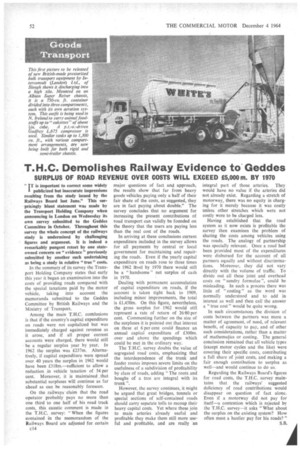T.H.C. Demolishes Railway Evidence to Geddes
Page 54

If you've noticed an error in this article please click here to report it so we can fix it.
SURPLUS OF ROAD REVENUE OVER COSTS WILL EXCEED 25,000m. BY 1970
"IT is important to correct some widely
I publicized but inaccurate impressions resulting from the study issued by the Railways Board last June." This surprisingly blunt statement was made by the Transport Holding Company when announcing in London on Wednesday its own survey submitted to the Geddes Committee in October. Throughout this survey the whole concept of the railways study is undermined by challenging figures and argument. It is indeed a remarkably pungent retort by one stateowned concern on " evidence " previously submitted by another such undertaking as ling a study in relative "true" costs.
In the summary of its survey the Transport Holding Company states that early this year it began an examination into the costs of providing roads compared with the special taxations paid by the motor vehicle, taking into account the memoranda submitted to the Geddes Committee by British Railways and the Ministry of Transport.
Among the main T.H.C. contlusions is that if the country's capital expenditure on roads were not capitalized but was immediately charged against revenue as it arose, and if all proper current accounts were charged, there would still be a regular surplus year by year. In 1962 the surplus was £237m. Alternatively, if capital expenditure were spread over 40 years the surplus in 1962 would have been £318m.—sufficient to allow a reduction in vehicle taxation of 54 per cent. Moreover, it is maintained that substantial surpluses will continue as far ahead as can be reasonably foreseen.
On the railways' claim that the road operator probably pays no more than one third to one half of his road track costs, this caustic comment is made in the T.H.C. survey: "When the figures contained in the memorandum of the Railways Board are adjusted for certain c14 major questions of fact and approach, the results show that far from heavy goods vehicles paying only a half of their fair share of the costs, as suggested, they are in fact paying about double." The survey concludes that no argument for increasing the present contributions of road transport can validly be founded on the theory that the users are paying less than the real cost of the roads.
In arriving at these conclusions current expenditure included in the survey allows for all payments by central or local government for maintaining and repairing the roads. Even if the yearly capital expenditure on roads rose to three times the 1962 level by 1970 there would still be a " handsome " net surplus of cash in 1970.
Dealing with permanent accumulation of capital expenditure on roads, if the account is taken right back to 1909, including minor improvements, the total is £1,450m. On this figure, nevertheless, the gross surplus for 1962 would still represent a rate of return of 26.80 per cent. Commenting further on the size of the surpluses it is pointed out that interest on .these at 6 per cent could finance an annual capital expenditure of £300m. over and above the spendings which could be met in the ordinary way.
The T.H.C. survey doubts the value of segregated road costs, emphasizing that the interdependence of the trunk and feeder routes imposes severe limits on the usefulness of a subdivision of profitability by class of roads, adding "The roots and boughs of a tree are integral with its trunk ".
However, the survey continues, it might be argued that great bridges, tunnels or special sections of self-contained roads should carry separate tolls to recoup their heavy capital costs. Yet where these join to main arteries already useful and profitable they make them still more useful and profitable, and are really an integral part of those arteries. They would have no value if the arteries did not already exist. Regarding a stretch of motorway, there was no equity in charging for it merely because it was costly unless other stretches which were not costly were to be charged less.
Having established that the road system as it now exists is profitable the survey then examines the problem of sharing the costs among vehicles using the roads. The analogy of partnership was specially relevant. Once a road had been provided most of the expenditures were disbursed for the account of all partners equally and without discriminations. Moreover, they did not vary directly with the volume of traffic. To divide out all these joint and overhead costs on "sundry formulae ", could be misleading. In such a process there was little of "costing" as the word was normally understood and to add in • interest as well and then call the answer a "true cost" would be quite wrong.
In such circumstances the division of costs between the partners was more a matter of agreement, of need, of relevant benefit, of capacity to pay, and of other such considerations, rather than a matter of mathematics or costing. The general conclusion remained that all vehicle types (except motor cycles and the like) were covering their specific costs, contributing a full share of joint costs, and making a fair enough contribution to surplus as .well—and would continue to do so.
Regarding the Railways Board's figures for road costs, the T.H.C. survey maintains that the railways' suggested deficiency of road contributions would disappear on question of fact alone. Even if a motorway did not pay for itself—a contention which is rejected by the T.H.C. survey—it asks "What about the surplus on the existing system? How often must a haulier pay for his roads?"
































































































































































































